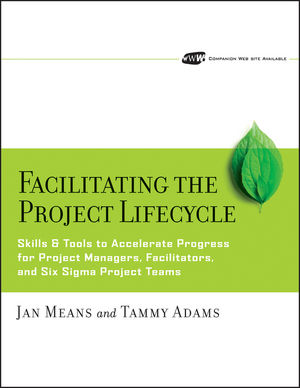Facilitating the Project Lifecycle: The Skills & Tools to Accelerate Progress for Project Managers, Facilitators, and Six Sigma Project TeamsISBN: 978-0-7879-7875-4
Paperback
312 pages
August 2005, Jossey-Bass
 This is a Print-on-Demand title. It will be printed specifically to fill your order. Please allow an additional 10-15 days delivery time. The book is not returnable.
|
||||||
Acknowledgments.
The Authors.
Introduction.
PART 1: THE POWER OF THE PARTNERSHIP: PROJECTS AND FACILITATION.
Section 1: The Commitment to Perform.
1. Old Dogs and New Tricks.
2. Facilitation Within the Project Lifecycle.
Section 2: The Ability to Perform.
3. Who’s on First?
4. What Effective Facilitation Is and Is Not.
PART 2: THE PARTNERSHIP IN PRACTICE: MAKING FACILITATED WORK SESSIONS WORK.
Section 3: Work Session Basics.
5. Making Work Sessions Work.
6. The Work Session Tightrope.
7. Preparing for the Work Session.
8. Conducting the Work Session.
9. Wrapping Up the Work Session.
Section 4: Facilitating the Deliverable.
10. Establishing the Project Charter.
11. Analyzing and Designing Business Processes.
12. Defining Business Requirements.
13. Assessing Risks.
14. Convening Work-in-Progress Reviews.
PART 3: THE TECHNIQUES.
Section 5: General Facilitation Techniques: Engaging the Group.
15. It’s All About Communication.
16. Flip-Charting.
17. Brainstorming.
18. Facilitated Dialogue.
19. Nominal Group and Affinity Analysis.
20. Prioritization Techniques.
21. Breakout Groups.
22. Staying On Track: Agendas, Action Items, and Other Focusing Techniques.
Section 6: Specialized Facilitation Techniques: Building the Deliverables.
23. Creating a Purpose Statement.
24. Defining Objectives and Targets.
25. Scope Framing.
26. Guiding Factors: Assumptions, Constraints, Dependencies, and Touch Points.
27. Discovering Impacts.
28. Risk Analysis Matrices.
29. Process Decomposition.
30. Process Mapping.
31. Process Detail Table.
32. Context Diagramming.
33. Requirements Table.
34. Developing a Timeline.
PART 4: RESOURCES.
A. Cross-Reference Tables for Tools and Techniques.
B. Recommended Books and Journals.
C. Recommended Web Sites.
D. Recommended Organizations.
References.
Index.
Templates on CD-ROM.
How to Use the Accompanying CD-ROM.



